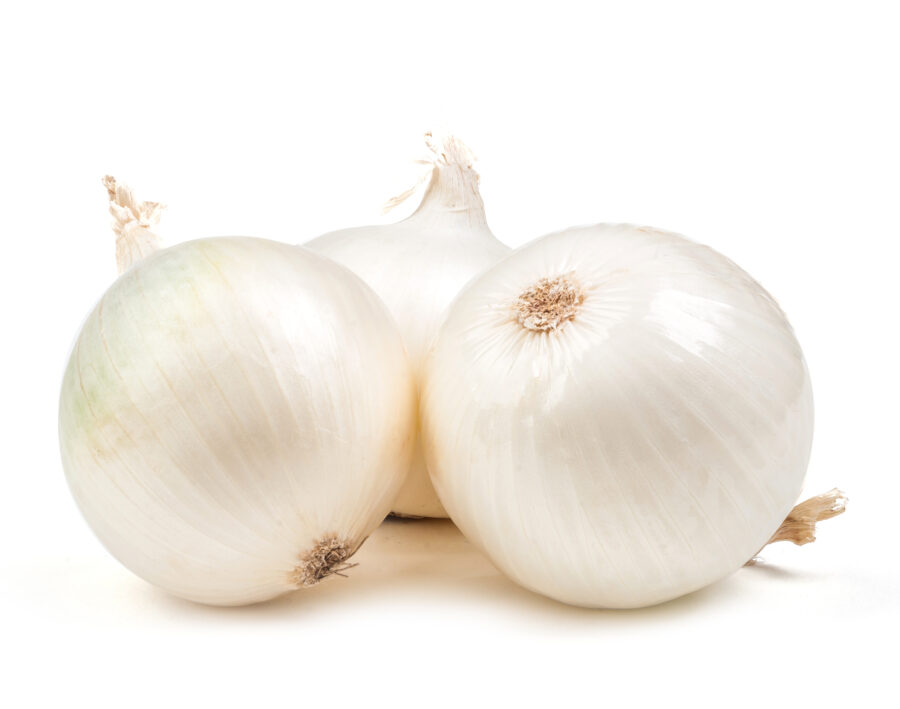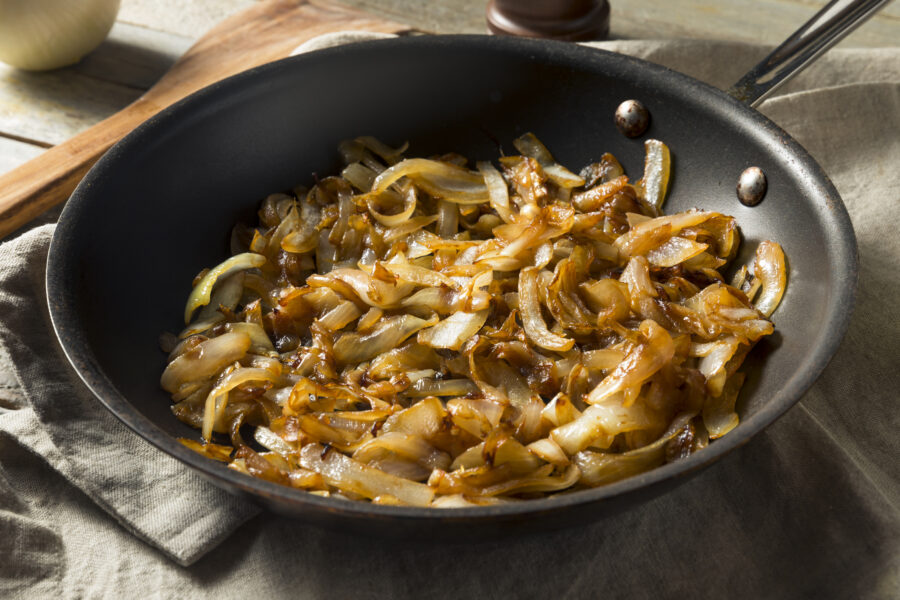When it comes to yellow vs. white onions, it can be hard to tell the difference. Even though these differences are slight, these two are by no means the same.
Introduction to Onion Varieties

We tend to group onions together, but they’re not all the same. Even though we’re judging yellow vs white onions, there’s a lot more than just two varieties.
There’s a lot of different onions out there. Within the larger categories of white, yellow, red, and green onions, there are even more specific subcategories.
These subcategories are organized via skin quality, region, maturation rate, storage potential, bulb shape, etc. We’re going to keep this comparison fairly simple, though.
What Are Yellow Onions?

Their name sums them up pretty well. Yellow onions have a yellowish skin, and are a bit darker on the inside than white onions.
They also taste better. Okay, maybe that’s more opinion than fact, but they do have a more distinctive taste, because of their high sulfur content (per The Cooking Dish).
This is why people tend to use yellow onions for their bold flavor. Some recipes specifically call for white onions, though yellow onions are a bit more popular.
Characteristics of White Onions

In contrast to yellow onions, white onions have a milder taste and a lighter color. They also have a higher sugar content (per The Deerholme Vegetable Cookbook).
This sugar content, combined with the low sulfur levels, doesn’t just affect white onions’ taste. It gives them a shorter shelf life than yellow onions, too.
While yellow onions have a more striking flavor, white onions are more versatile. They give your meal a nice crunch without overpowering it.
Taste Comparison: Yellow vs. White

We’ve already touched upon the taste differences between yellow vs. white onions. Still, it can’t hurt to go into a little more detail, can it?
So, the yellow ones are the ones with the more noticeable flavor. If you want that strong onion flavor in your next dish, opt for them.
White onions are nowhere near as onion-y. Sure, if you eat it raw, you’ll definitely taste the onion, but they’ll give your dish a more balanced flavor.
Textural Differences in Cooking

While onion skin is generally thin, there’s a significant difference when it comes to yellow vs. white onions. Yellow onion skin tends to be thicker than white.
White onions, in comparison, have more papery skin. It usually comes off a lot easier than yellow onions’. So, what about the onions’ flesh?
Yellow onions are more crisp. They’re harder than white onions, which can be softer and more tender. Generally, though, onions’ texture changes depending on how they’re cooked.
Nutritional Content

As onions’ texture changes depending on how they’re cooked, so does the nutritional content. According to Healthline, raw onions are low in calories and high in vitamins.
Most onions include vitamins C and B6, along with potassium and folate. Yellow onions are rich in antioxidants, on a level that white onions can’t even compete with.
In fact, they’ve got eleven times more antioxidants than white onions. That doesn’t mean that white onions are useless — they’re also low sodium.
Yellow Onions in Recipes

These onions can be interchangeable in most recipes. However, the taste differences between yellow vs. white onions often calls for different types of recipes.
For example, yellow onions are ideal for caramelizing. They’re not inherently sweet, so the flavor will be a nice balance between sweet and savory.
Yellow onions also do well in soups and stews. Their strong flavor distributes well. The next time you whip up French onion soup, use yellow onions.
Ideal Dishes for White Onions

White onions’ flavor aren’t as strong as yellow onions’, but that doesn’t mean that they can’t be utilized. They shine best when used raw.
That’s why you’ll often see finely chopped white onions in salads and tacos. They have some nice flavor and texture, without overpowering the dish.
You can also use them in a fresh, homemade salsa. Their mild flavor enhances it, while giving the other ingredients their time to shine.
Growing Conditions and Cultivation

Both yellow and white onions require pretty similar growing conditions. Most onions generally have shallow roots, and require moist soil, 24/7 (per Bonnie Plants).
They also need ample sunlight, and should have a good amount of space in between each other. A good six inches in between each onion does the trick.
It’s best to plant onions in the springtime. The balance of sunlight and rain will give you a bountiful harvest of onions, yellow or white.
Availability and Seasonality

Yellow and white (and red!) onions are available all year long, though it’s a bit more complicated than that. As we mentioned earlier, onions have subcategories.
One of these subcategories is the seasons they’re available in. Onions from the spring and summer tend to taste milder than their fall and winter counterparts.
Fall and winter onions last longer and are more pungent. Though there’s variations from color to color, the seasons are important, too (per National Onion Association).
Cost Considerations

The cost of yellow vs. white onions depends on the vendor. Buying onions at the most expensive grocery store in the world will cost more than at Walmart.
However, the grocery store isn’t the only factor. White onions, with their sweet flavor, are generally a bit more expensive than yellow ones.
Yellow onions are actually cheaper than both white and red onions. So, if you need an onion in a pinch, go for yellow onions over white.
How to Store Yellow and White Onions

Most onions call for the same storage techniques. They all release moisture, which can wreak havoc on the foods around them. So, store them by themselves.
You’ll also want to keep both yellow and white onions in a cool, dry place. You know how onions are usually sold in mesh bags?
That’s because they need to be kept well ventilated, so keep them in that bag. Once you’ve cut your onions, pop them in the fridge.
Handling and Prepping Tips

Rule number one of handling onions: always wash your hands. Everyone washes their hands before handling food, but remember to wash them after, too.
I’ve chopped onions, forgot to wash my hands, and rubbed my eyes more times than I can count. It’s terrible. Definitely would not recommend.
You’ll also want to make sure that the cutting board and dishes you use are clean. This will ensure your health and safety before eating.
Onion Allergies and Sensitivities

While it’s not exactly common, allium allergies do exist. If onions (and garlic) make you feel nauseous or give you an itchy throat, then you might have one.
Of course, it’s always best to consult your doctor with these matters. We know a thing or two about food, but we’re definitely not allergy experts.
Onions are also gluten free, like every vegetable. Ultimately, onions are compatible with most diets, unless you’re allergic to them or their food group.
Cultural Significances

To me (and probably you, too), onions are nothing more than a savory add-on to a dish. Delicious, yes, even necessary, but by no means sacred.
To the ancient Egyptians, it was another story. Onions were a vital vegetable that symbolized eternal life. They were buried with pharaohs (per New Mexico State University).
Nobody knows what exactly it was about onions that they found so appealing, but there are theories. One is that the strong scent could revive the dead.
Chefs’ Onion Preferences

From professional chefs to home cooks, there’s one onion that rules kitchens the world over: the yellow onion. It’s flavorful, versatile, and cheap, to boot.
White onions are a little more niche. They’re used in specific dishes, though they are widely used in a variety of dishes in Mexican cuisine.
Ultimately, it depends on the chef, what they’re cooking, what’s available to them, and their own personal preferences. You should go with what works best for you.
Popular Onion-Based Dishes

Calling any dish “onion-based” feels a little disingenuous. Onions are rarely the star of a dish; rather, they serve as a side, to enhance the dish they’re in.
One of the most popular onion dishes is French onion soup. This hearty dish, popularized in America by Julia Child, is like comfort in a bowl.
Onions also work great in a myriad of sauces. White onions are perfect for salsas, whereas yellow onions are great for a classic onion dip.
Innovative Recipes

Well, okay. Most dishes use onions to enhance. There are definitely a few more innovative dishes that have onions as the star of the show.
One of these is roasted onions. They are usually used as a side dish; however, since the onions themselves are the only ingredient, we’re counting it.
It’s a pretty simple process. Chop them in half, bake them in the oven, and boom! They’re ready. Season with salt and herbs.
Future Trends in Onion Cultivation

A lot of these new onion cultivation trends involve farmer’s jargon. Since we (and probably you) aren’t farmers, we’re only going to touch upon it.
Like most products, the cost of onions has shot up. According to AgWest Farm Credit, a water shortage in Mexico has led to less onions, increasing demand.
In terms of growing techniques, it doesn’t look like those are changing any time soon. A lot of it depends on the weather and the time of planting.
Yellow vs. White Onion: Which Wins?

Alright, yellow vs. white onions: which one comes out on top? Well…neither? I mean, I know that I personally prefer yellow onions for their versatility and cost.
However, white onions still have their place, especially in Mexican cuisine. Even if I prefer yellow onions, I can’t deny how good white onions taste in pico de gallo.
This wasn’t meant to be a competition, so we can’t declare a decisive victory. The winner is the onion that’s the easiest for you to obtain.


